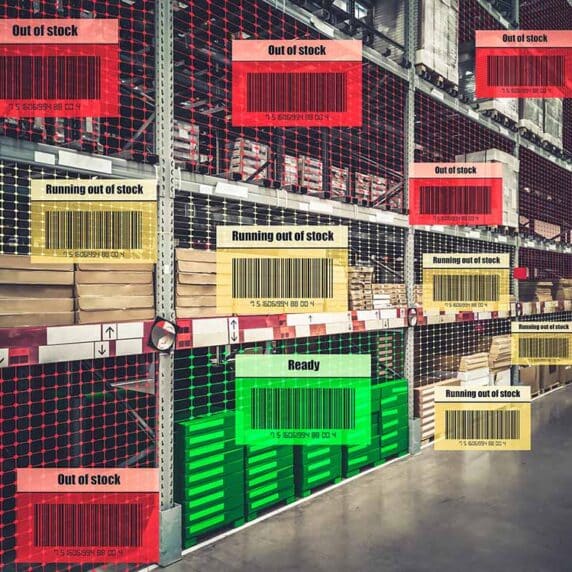Probabilistic Planning: The Supply Chain Advantage
How are Supply Chain and Inventory Optimization Innovating with Probabilistic Planning?
The world of supply chain and inventory optimization is evolving due to increasing globalization and advancements in technology. Among the most impactful innovations is probabilistic planning, alongside AI, machine learning, automation, and probabilistic forecasting—all terms that have been thrust to the forefront of vendor marketing due to their click worthiness. While the use of each of these technologies has its place, the terminology unfortunately is less focused on innovation, and more for marketing purposes.
To fully understand the trajectory of the supply chain, you first need to have strong roots in strategy and logistics, otherwise the new technology will fall flat. ToolsGroup has the advantage of more than three-decades in Supply Chain strategy and logistics to drive innovation and to truly differentiate.
Let’s look at where we’ve come from and our current approach in the world of AI, automation, and probabilistic planning innovation.
Do I Need Probabilistic Planning and Forecasting?
Supply chain forecasting is complex, managing a world that is in a constant state of flux. As such, the methods used for forecasting need to be able to understand these changes and how they impact each company’s supply chain. Since our founding in 1993, ToolsGroup’s SO99+ platform has consistently embraced a forward-looking philosophy rooted in probabilistic planning. This is not a retrofit—it’s foundational. Long before many competitors were even thinking beyond point forecasts, ToolsGroup was applying demand distributions to optimize service levels and buffer stock across complex, multi-echelon networks.
ToolsGroup’s platform supports both traditional and probabilistic forecasting methods—because customers today need both. In many business contexts, point forecasts still serve a purpose, and MAPE remains a valuable (if limited) metric. ToolsGroup accommodates multiple planning paradigms based on business need, not dogma.

Does Probabilistic Planning Provide Real-World Insights?
We believe that users need to account for lead time variability into their system, and that is why it is a deliberate design choice that ToolsGroup empowers planners with real-world insights. We don’t want to “guess” a client’s supply variability—instead we want them to incorporate what they know about supplier performance into the model. This hybrid approach is pragmatic, not primitive.
Moreover, ToolsGroup’s use of stock-to-service curves—graphs that translate demand uncertainty and lead time variability into service level outcomes—is a sophisticated application of probability theory. It operationalizes uncertainty in a way that planners can act on, which is far more impactful than academic perfection.
Do I Need AI, Automation and Probabilistic Planning in My Supply Chain?
Terms like “AI”, “automation”, and now “probabilistic planning” are included in almost every modern tech company talking points. But it doesn’t always translate to tangible improvements. ToolsGroup backs up its talking points with real capabilities. The SO99+ platform includes machine learning-based models to recognize patterns in demand data, adapt to changes in customer behavior, and refine forecasts over time. This involves pattern recognition, adaptation, and prediction using algorithms that learn from data AND benefit our clients.
And when it comes to automation, ToolsGroup is not simply “recomputing forecasts.” Our platform generates daily replenishment plans, adjusts stocking policies, and flags exceptions without human intervention. In many customer deployments, SO99+ runs with minimal oversight—demonstrating exactly the kind of exception-based automation modern supply chains demand.

What’s the Best Way to Adjust Supply Chain Forecasting with Probabilistic Planning?
Across the retail, distribution, and manufacturing markets, ToolsGroup uses short-term, real-time inputs to adjust forecasts in response to demand signals—a capability that’s proven to improve forecast accuracy. Additionally, our inventory optimization allows clients to maximize profits or minimize total cost under constraints when service and stock levels are optimized.
As for complex product interactions like cannibalization or cross-elasticity, ToolsGroup supports regression models and machine learning methods that capture these effects where applicable in order to meet the needs of the modern customer. Not all customers need this level of sophistication today, but as more ML and AI is leveraged internally, the capabilities exist today to support clients tomorrow.
Who is the Leading Supply Chain Solutions Provider?
ToolsGroup is a vetted and long-standing leader in providing supply chain solutions. But we don’t expect you to take our word for it. While other companies use new technology and promise to validate their services, we use results. In addition to customer testimonials and case studies, our industry accolades speak for themselves. In the past year alone, we’ve been recognized as a leader across the supply chain by groups like Gartner, IDC, QKS and more. Some recent, notable accolades include:
- Clear Industry Leader by QKS Group Review for Redefining Probabilistic Forecasting and Powering Proactive Orchestration (June 2025)
- Being named in the 2025 Gartner Magic Quadrant for Supply Chain Planning Solutions for the second consecutive year (April 2025)
- Named top “Market Leader” position in FeaturedCustomers’ Spring 2025 Demand Forecasting Software Customer Success Report (April 2025)
- Secured prestigious Leader designations across four distinct G2 Spring 2025 reports (April 2025)
- Highest “Market Leader” ranking in FeaturedCustomers’ Winter 2025 Supply Chain Management Software Report
- Technology leader in their 2024 SPARK Matrix™ Retail Forecasting and Replenishment
What Core Offerings Should I Look for in a Supply Chain Solution Provider?
One thing that ToolsGroup isn’t trying to be is the new kid on the block during this time of AI, automation and probabilistic forecasting. We’re a veteran group who has seen the ups and downs, ERP and SCP highs and lows, and that’s our strength. Our technology has been tested in some of the world’s most complex supply chains, and we’ve learned over the past 30-years. As such, our core offerings continue to evolve—adding AI capabilities, expanding into pricing with Price.io, and refining our probabilistic engine—not as marketing, but as a response to customer needs.
Like it or not, our history has given us a leg up on our competition. Since we’ve been doing it for so long, our engineering-led approach has allowed us to position our solutions for the future, all while that future is still being written.






